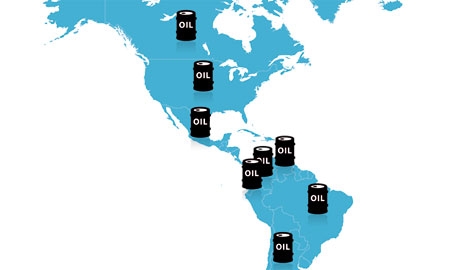Mexico and the U.S. have been long-standing partners in many areas and both countries are set to benefit from the Mexican Energy Reform. The two have long relied on one another for critical energy supplies, with the U.S. currently purchasing over 70% of Mexico’s oil exports. It is a common misconception that the U.S. relies on the Middle East for most of its oil; Canada and Mexico, together, provide nearly 40% of U.S. oil imports, and Mexico consistently ranks among its top three suppliers.
According to the Energy Information Administration (EIA), only Canada and Saudi Arabia supply more crude to the U.S. than Mexico, exporting 937.6 million and 483.6 million barrels per year, respectively, in 2013. Nevertheless, Mexico’s oil exports to the U.S., amounting to 310.4 million barrels per year, are remarkably higher than Venezuela’s 275.5 million barrels; they also more than double or triple those of other major oil producers, such as Iraq (124.4 million) and Nigeria (87.4 million).
A safe and reliable source
A stable democratic system, reliable judiciary, new clear and transparent processes, friendly and diverse diplomatic relations and geographical proximity all help to position Mexico as the U.S. hydrocarbons supplier of choice. The legal certainty that Mexico offers North American investors thanks to its Energy Reform, will give the country an advantage over other oil producers.
Moreover, because it is not a member of the Organization of Petroleum Exporting Countries (OPEC), Mexico enjoys a greater degree of flexibility and competitiveness to meet the needs of consuming countries. Over the past five years, the U.S. has cut down significantly on net oil imports, favoring non-OPEC exporting countries. While the U.S. reduced its OPEC-sourced imports from 2.2 billion barrels in 2008 to 1.3 billion last year, non-OPEC oil imports only dropped from 2.5 billion barrels to 2.2 billion.
The new energy landscape
Since the 1920’s – when Mexico became a global energy power, ranking second in oil production worldwide – the country has served as a critical partner to the growing American economy. Today, despite a decade of declining production, Mexico remains an indispensable furnisher of the world’s energy supplies.
According to Petróleos Mexicanos (Pemex), it ranks 10th globally in terms of oil production, at nearly 2.5 million barrels per day (bpd) – down from 3.4 million bpd in 2004. Additionally, Mexico’s total proved reserves rank 19th in the world, estimated by the EIA at over 10 billion barrels and worth nearly $1 trillion at today’s prices. Furthermore, Pemex cites a figure of 42.1 billion barrels of 3P reserves, referring to proven, probable and possible reserves.
 |  |
Shinzō Abe, Japanese Prime Minister
| Adam Sieminski, Administrator of the Energy Information Administration |
Interestingly, the move towards opening Mexico’s energy sector coincides with the U.S.’s resurgence as a major oil and gas producer. As a result of heavy investment and the development of innovative technology for extracting unconventional oil and gas resources, the so called “shale revolution” has put the U.S. on track to challenge Saudi Arabia as the world’s leading oil producer.
The new available techniques have also placed the U.S. within reach of achieving energy independence. One of the expected results of the Energy Reform is the transfer of this knowledge and technology to spur innovation and investment in Mexico, allowing it to achieve its full potential as a true energy giant.
There are also good reasons to be optimistic about Mexico’s shale oil and gas prospects. Its territory holds the world’s eighth largest technically recoverable shale oil reserves and the sixth largest shale gas reserves, according to estimates published by the EIA. In terms of oil alone, bringing in the required investment and technology to exploit these resources would add 13 billion barrels, which would more than double the country’s current proven reserves.
With the historic constitutional reform comes a renewed engagement with leading international oil companies. American firms will be natural partners in this development, as they have largely pioneered shale oil and gas extraction worldwide and possess the critical tools and experience derived from working in neighboring and geographically similar areas along the border and the Gulf of Mexico.
The Energy Reform, arguably the most groundbreaking legislation in Latin America of the last decade, will not only boost Mexico’s economy and the prospects of its citizens, but it will also change the energy landscape as we know it today. An energy power has emerged.






0 COMMENTS